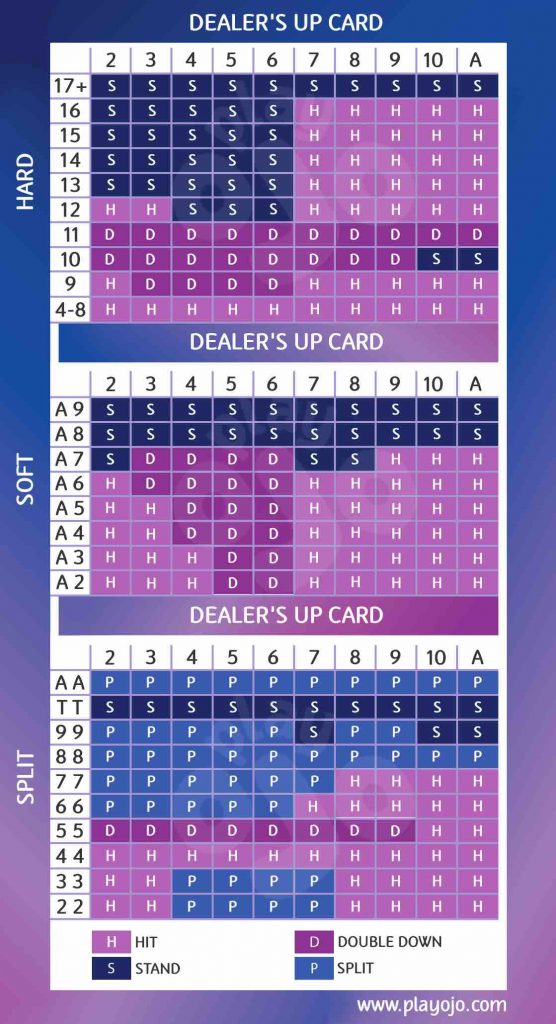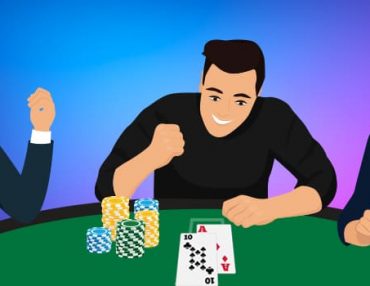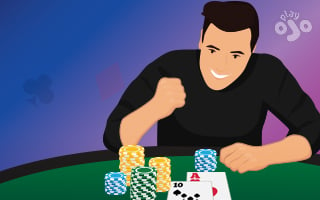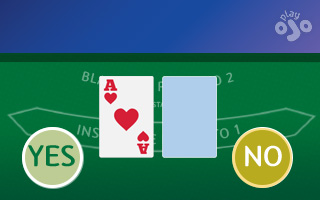Disclaimer: Remember, the outcome of games is always entirely based on luck and the house will always have the edge. You should never try to recover losses by gambling more.
Blackjack involves much more skill than other casino games, but luckily there’s a set of rules anyone can use to play perfectly, and it’s called Basic Blackjack Strategy. In this blackjack strategy guide, you’ll learn everything you need to play better blackjack, have more fun and keep the house edge as low as possible.
You don’t need to be a maths whizz or practise for years to see the benefits of the most optimal best blackjack strategy. However, it might be worth brushing up on common blackjack terms. The expert knowledge contained in these charts and simple rules of thumb is easy to learn and will instantly improve your play.
A word of warning: There are no blackjack strategies that work for every hand or every session, because in the short term, luck will always be a bigger factor than skill. But over the long term, players who follow advice in basic strategy charts will see better results than those who don’t.
Also note that I won’t be covering blackjack side bets in this blog post as the outcome of those is much more dependent on luck than skill. Strategy is all about leveraging your skill in the game, so we’ll keep the focus on those aspects of blackjack.
Be sure to check out the full details of blackjack insurance for advice on when (and if!) you should take advantage of this unique bet.
WHAT IS BASIC BLACKJACK STRATEGY AND WHY DOES IT MATTER?
Quite simply, this set of 200 or so individual rules and blackjack tips is your roadmap to playing perfect blackjack strategy. Although it’s called ‘basic’, it is actually the ultimate blackjack guide to every decision you’ll face in all blackjack games.
Make no mistake, the optimal blackjack system won’t help you win at blackjack consistently (counting cards is the only way to do that, and thanks to RNGs in online games, it’s pointless anyway!), but it will help you reduce the house edge.
When you play a blackjack game online, following the best blackjack strategies in every scenario will get you as close as possible to the ‘optimal Return To Player’. This means your bankroll will last longer and you’ll get more bang for your buck.
The purpose of blackjack basic strategy is to lose the least amount of money in the long run.
If a game of European Blackjack has an RTP of 99.29%, that’s based on the assumption that you’ll make the best move every time you play.
Even the most experienced blackjack players may slip up in less common situations where it’s hard to choose between two blackjack tactics. Learning a strategy card or keeping a copy to hand is the only way to ensure you’re not giving the house more than they deserve!
Strategic errors can turn blackjack from a casino game with the highest RTP to one with the lowest. As you can see from this table, knowing when to hit or stand is the most important decision in blackjack, while doubling and splitting also have a small but significant impact.
Action | House edge if used incorrectly |
Stand or hit | +3.50% |
Double | +1.60% |
Split | +0.40% |
BLACKJACK STRATEGY CHARTS
It’s not really practical to calculate the optimal move for more than 9 billion combinations of player and dealer cards on the fly, which is where the blackjack strategy chart comes in.
Once you know your starting hand and the dealer’s up card, a blackjack strategy card like the one below lets you quickly find out the recommended move that will produce the best outcome in the long run, ie. maximise your profits and minimise your losses.

Choose these blackjack strategy cards with care: rules can vary from one game to the next, particularly when it comes to Soft 17 blackjack rules and number of decks used.
In this article, I’m going to use the most popular set of rules for playing online blackjack at a UK online casino: an 8-deck game where the dealer stands on Soft 17.
SURRENDER RULES IN BASIC STRATEGY

Sometimes when you play blackjack, your chances of winning are so small that it’s better to forfeit your hand, get half your money back and move onto the next battle.
If used correctly, the blackjack surrender rule can cut 0.60% off the house edge.
The standard blackjack strategy is to only surrender if your chance of winning a hand is 25% or lower, and there are only a handful of blackjack scenarios where this happens:
- Surrender 16 against 9, 10 or Ace. Hitting is the standard play and results in a 57p loss for every £1 you stake. If you surrender, you lose 50p instead.
- Surrender 15 against 10 or Ace. Against an Ace, you lose 64p on average, so surrendering 50p is clearly the better play.
BLACKJACK STRATEGY FOR SPLITTING PAIRS

Of all the decisions you’ll take at the table, splitting pairs is the least important, but doing it wrong will still cost you a small edge in the long run.
There are 2 reasons to split a pair. Either you’re getting more money in play against a weak dealer hand, or your cards work better alone than they do together.
Blackjack strategies for splitting can be summed up with these 3 rules:
- Never split Tens. We turn 1 hand worth 20 that wins most of the time into 2 hands that are likely to end up being worse.
- Always split Aces except against an Ace. You might only get 1 card but Aces are worth 11, the magic number!
- Split any pair except Tens and Fives against a weaker dealer card. This is a broad rule of thumb and there are exceptions.
STRATEGY RULES FOR DOUBLING DOWN

In a game where you’ll win the hand only 42% of the time, you need a secret weapon to balance the scales. Winning 3 to 2 for Blackjack is by far the most important advantage you’ll get, but when used correctly, the blackjack double down option is a powerful tool as well.
Doubling is as much about capitalising on dealer weakness as it is your own card strength. Of the 48 squares in blackjack charts that advise you to double, 38 occur when the dealer has 6 or less.
- Double on 9, 10 or 11 when the dealer’s up card is the same or lower than yours.
- Avoid doubling on 11 against 10 or Ace. It’s still (very marginally) profitable, but hitting is a more profitable play.
- Double on all Soft hands worth 18 or less against 5 and 6. Doubling Soft hands that include an Ace is one of the secrets of winning blackjack. There are exceptions to this rule in strategy charts, but in general, this will serve you well.
HITTING AND STANDING: THE BREAD & BUTTER OF BLACKJACK STRATEGY

If you can’t surrender, split or double, you’re left with 2 options; hit or stand. This is the most common situation you’ll find yourself in, which means blackjack strategy rules for hitting and standing are the most important blackjack rules to learn.
WHEN TO HIT IN BLACKJACK
While there are various reasons to stand, double or split, there is only 1 reason to hit and take another card in blackjack: your hand isn’t good enough yet!
Left as it is, your hand won’t beat the dealer’s often enough to be profitable, so you need to improve your score.
If your hand is worth 11 or less, you can hit without fear of busting. With 12 or more, it’s a different story. A lot of blackjack players fear busting and stand instead of hit, choosing to take their chances with a weak hand, probably because they’ve seen it win.
But the numbers are the only thing that matters when you play blackjack online, and it’s often necessary to try and improve your hand, even when your risk of busting is high.
When you hit on 16, you’ll bust 62% of the time. But if the dealer has 7 or more, they’ll make 17 or more so often that you must take that risk.
- Hit on 8 or less. You cannot bust yet, so there’s nothing to be scared of. If you have 9, 10 or 11, the same is true but doubling down often becomes the most profitable play.
- Hit 9, 10 or 11 against an Ace or 10. You can’t busy yet and doubling is too aggressive.
- Hit on 13 to 16 against a 7 or more. The dealer will make a pat hand over 60% of the time, so your hand won’t be enough as it stands.
- Hit on 12 against a 2. You might not expect to hit with 12 against low dealer cards, but 12 is a special case. There’s an old blackjack saying that “2 is a dealer’s Ace”, as it enables them to make a pat hands so often (about 2 out of 3 times).
- Hit Soft 18 or less against 9, 10 or Ace. With the safety net of not being able to bust, it’s usually correct to hit and try to improve your hand.
- Hit all pairs from Sevens down against a dealer’s 8 or more. Better to take your chances rather than creating 2 new weak hands.
WHEN TO STAND
When blackjack simple strategy says to stand, it’s usually because your hand is in good shape, or your hand is bad but so is the dealer’s!
In all cases, sticking with what you’ve got is better than risking going bust.
To illustrate why it’s often so important to stand and rely on the dealer busting, here are the bust rates for all dealer up cards.
As you can see, against 4, 5 or 6, you’ll win automatically over 40% of the time, whatever cards you’ve got.
Dealer up cards and how often they will bust
2 | 3 | 4 | 5 | 6 | 7 | 8 | 9 | 10 | 11 |
35% | 36% | 40% | 42% | 42% | 26% | 24% | 23% | 21% | 12% |
STANDING RULES
- Stand on Hard 17 or more against any card. Your hand is in good shape against most dealer cards, plus it would be suicidal to hit!
- Stand on Hard 12 to 16 against 2 to 6. The dealer will bust between 32-45% of the time, so we shouldn’t risk busting ourselves. There is an exception when you have 12, when standing is not the right play. This is due to a combination of lower dealer bust rate and your own improved rate of making a better hand.
- Stand on Soft 19 and Soft 20. You’re in good shape against any dealer card, and your hand is too strong to risk making it worse by doubling down. The exception is Soft 19 against a 6, when you should double instead. The dealer’s hand is just too bad to pass up the chance to double down.
- Stand on Soft 18 against at 7 or 8. With soft 18 you should double, stand or hit depending on the situation. Standing against a 7 or 8 is the logical play.
Remember, to get the most out of your online blackjack experience, always play responsibly.
Disclaimer: Remember, the outcome of games is always entirely based on luck and the house will always have the edge. You should never try to recover losses by gambling more.
















